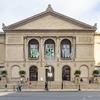More about Waterloo Bridge, Sunlight Effect
- All
- Info
- Shop

Contributor
Faced with London’s foggy weather, French painter Claude Monet transformed the grim metropolis into a dreamlike landscape in his Impressionist masterpiece Waterloo Bridge, Sunlight Effect.
Every morning, Monet would rise before dawn and step out into the crisp winter’s air on the balcony of his room at the Savoy hotel, hoping to find the magnificent view on Waterloo bridge within the mysterious fog. With his light brushstrokes, he would then capture the gray London skyline in an idyllic, soft-focused oil painting in bright pastel colors. Around noon, for a visual change, he would turn to the view of Charing Cross Bridge just opposite, obscured by the same thick haze. And to round up his day, he would venture out for an evening stroll to St. Thomas Hospital on the other side of the river. From here, he would paint the Houses of Parliament engulfed in a misty sunset light.
With this daily routine, Monet studied the effects of different weather and light conditions on the same scenery. These three series of London’s famous landmarks were to become part of Monet’s larger London Series, a visual ensemble consisting of almost 100 views of the Thames river.
For Monet, a country guy residing in the picturesque French village of Giverny, it was not the metropolis’s architecture that charmed him. What lured him to a city so different from his home on three chilly winters between 1899 and 1901 was the infamous London fog. For Monet, it endowed the grimy urban landscape with an otherworldly appearance. "London would be quite ugly if it was not for the fog", he once remarked to his wife.
Working with London weather, however, is not that straight-forward. Waiting for the perfect fog is one thing; but how to capture a scene through the tedious process of painting when the weather is bound to change within minutes? Monet was prepared. Rather than finishing one painting at a time, he started working with different canvases simultaneously. When the right atmosphere appeared, he took out the corresponding canvas, refined it as needed, and exchanged it for another one once the weather changed. His work did not end here. For perfectionist Monet, painting in series meant also altering the paintings so that they would harmonize with each other and form a visually coherent set. For the 41 Waterloo Bridge paintings it would take Monet a few years before he considered them finished and agreed to send them to his art dealer.
Luckily, Monet’s new approach did not require him to stay in hazy London long in order to complete his work (there’s only so much fog one man can take!). Instead, he swapped the view of massive Waterloo Bridge for one of a picturesque Japanese footbridge, surrounded by the now familiar water lily ponds and blooming irises, as enjoyed from the comfort of his home and garden in Giverny.
Sources
- Cartwright, Mark. “Claude Monet.” World History Encyclopedia. April 04, 2022. https://www.worldhistory.org/Claude_Monet/
- Fady, Theophraste. “Monet’s Pied-a-Terre.” Strandline. September 09, 2019. https://www.strandlines.london/2019/09/09/the-savoy-monets-pied-a-terre/
- House, Christian. “Monet’s Otherworldly Depiction of Waterloo Bridge.” Sotheby’s. January 31, 2020. https://www.sothebyscn.com.cn/en/articles/monets-otherworldly-depiction…
- Needham, Alex. “Monet’s Waterloo Bridge Drawing on Show at Savoy Hotel.” The Guardian. December 12, 2011. https://www.theguardian.com/artanddesign/2011/dec/12/monet-waterloo-bri…
- Randerson, James. “Hospital View. Experts decipher where Monet was standing.” The Guardian. August 9, 2006. https://www.theguardian.com/uk/2006/aug/09/science.arts
- “Scientists pinpoint Monet’s London balcony.” NPR. June 12, 2010. https://www.npr.org/2010/06/12/127795046/scientists-pinpoint-monets-lon…
- Sherwood, Harriet. “Waterloo Bridge Masterpiece by Claude Monet expected to sell for £24m.” The Guardian. May 30, 2022. https://www.theguardian.com/artanddesign/2022/may/30/waterloo-bridge-ma…
- “The Houses of Parliament (Effect of Fog).” The Met. Accessed June 29, 2022. https://www.metmuseum.org/art/collection/search/437128
- “Waterloo Bridge, Sunlight Effect.” Art Institute Chicago. Accessed June 28, 2022. https://www.artic.edu/artworks/20701/waterloo-bridge-sunlight-effect
- Zahorsky, Grant. “The Unknown Monet of London.” Londonhua Wiki. Last Edited June 22, 2017. https://londonhuawiki.wpi.edu/index.php/The_Unknown_Monet_of_London












